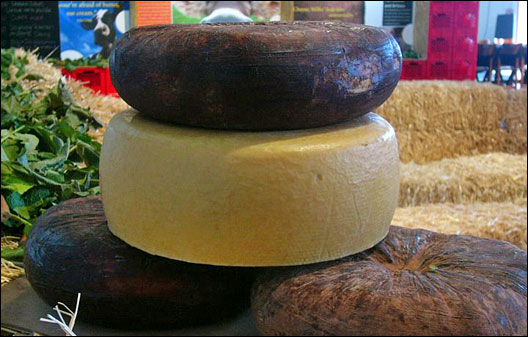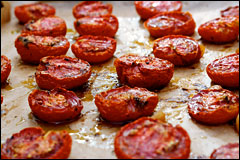
It’s going to take me more than just a few days to fully understand the effects and implications of the first Slow Food Nation, held in San Francisco over Labor Day weekend. The brain power on display was impressive enough: Wendell Berry, Vandana Shiva, Michael Pollan, Winona LaDuke, Carlo Petrini, Raj Patel, Eric Schlosser, and other luminaries took center stage at panels. Add to that the myriad of other events and mind-blowing food, and you get a truly unforgettable event for the thousands who attended.
Despite the multitude of free activities at Slow Food Nation, I heard in the weeks leading up to it that it was all too expensive and was further evidence of food snobs run amok. Yet during the event, the chief complaints I heard were that it was too crowded and that the events that did cost money were all sold out. So while accurate numbers on attendance are still being calculated, it was easy to see that attendance exceeded expectations, and that those who appreciated its worth outnumbered those who did not.
As to the elitism charge, while there are those who will not be convinced otherwise regardless of what Slow Food says or does, it simply does not hold up upon close examination of Slow Food’s work as an organization on the whole. Does it contain members who are snobs or who occasionally act snobby? With 17,000 members before this event and predictions by some that that number may double as a result of it, yes, there is no doubt that in a sampling that large you will find some — perhaps quite a few — “elitists.” But to dismiss the organization’s important work, from networking rural farmers in Africa to helping revive milpas in Mexico, simply because much of what Slow Food does is academic or expensive is myopic.
Slow Food does not do everything right and will never please everyone, nor is it any form of panacea, nor does it claim to be. It can and has made lives better for thousands of people not just in the U.S. and Italy (where it was founded) but from Bolivia to the Ivory Coast to India by supporting farmers and aiding to reinvigorate local food traditions. Here in the U.S. it raised thousands of dollars to help the farmers and fishers affected by Katrina, then raised thousands more for Midwest flood relief. Already Slow Food USA has turned its attention once more to the Gulf in the wake of Hurricane Gustav.
The event itself was a joy to behold. At one of the free events, called the Soapbox and held adjacent to the Victory Garden in San Francisco’s Civic Center Plaza, speakers and performers offered a huge range of ideas, from the political to the poetic (sometimes both), through speeches and dance, drumming and prayer. Especially moving was a performance by peach farmer David Masumoto and his daughter Nikiko of a poem about a hailstorm that wiped out an entire harvest accompanied by the traditional Teiko Japanese drum. Some in the audience wept as they heard the thunder and felt the hail rip the flesh of the peaches.
In the end many people came just for the food, and it was indeed excellent food, from the Indian naan to the Native American Manoomin rice cakes to Iowa prosciutto to abalone to tamales to mufaleta. But they came away with a message, one summarized in the Declaration for Healthy Food and Agriculture, which urges the government to adopt “twelve principles [that] should frame food and agriculture policy, to ensure that it will contribute to the health and wealth of the nation and the world.” I strongly encourage you to read it and decide if you want to endorse it.
Amid the divine madness of the event, I didn’t have a chance to put together a recipe. But my colleague Bruce Cole, editor of Edible San Francisco, graciously granted me permission to reprint the following delectable recipe for tomato pesto. It originally appeared in the August/September 2008 issue of Edible San Francisco.
Tomato Pesto
Recipe by Rachel Cole

Life in the slow lane.
Photo: Bruce Cole / Edible San Francisco
According to Rachel Cole, the world of Italian pesto extends beyond that addictive green sauce featuring basil. The word pesto, she writes, originates in the verb “to pound,” and pesto is a “family of sauces that includes any paste made from pounding together ingredients in a mortar and pestle to meld the separate components and flavors.” This one highlights (and concentrates) the flavor of tomatoes, now at the height of harvest over much of the country.
1/3 cup best-quality extra virgin olive oil
3/4 teaspoon sea salt
1/4 teaspoon freshly ground pepper
6 large cloves garlic, peeled and trimmed
1/2 cup pine nuts, toasted
3/4 cup freshly grated Parmigiano-Reggiano cheese
- Position oven racks on the upper and lower thirds of the oven and preheat to 225 degrees. Line two large rimmed sheet pans with parchment paper rubbed with olive oil, or with non-stick silicone mats.
- Slice tomatoes lengthwise and cut a V around stem to remove. In a large mixing bowl, combine tomatoes, olive oil, salt, pepper, and three of the garlic cloves. Toss gently together to coat. Arrange tomatoes, cut side up, and the oiled garlic in one layer on each sheet pan, spaced slightly apart. Set aside any extra juice or oil left in the mixing bowl.
- Place sheet pans in the oven and roast for one hour, then reverse the pans and rotate each 180 degrees. Repeat every hour for at least four hours and up to six. Tomatoes are ready when they have reduced in size by at least half and have begun to caramelize. Allow to cool for 10 minutes. (Do your best to resist eating them all at this stage!)
- In a food processor, combine tomatoes, roasted and raw garlic, reserved juices and oil, and pine nuts; process for 30 seconds. Add Parmesan and pulse until combined but still chunky. If making pesto in advance, transfer to a bowl and cover until ready to serve.
Any extra pesto can be refrigerated up to a week; if freezing, wait to add the raw garlic and Parmesan until thawed and ready to eat.
(Makes about 4 cups — way more than enough to sauce a 1-pound package of dried pasta such as spaghetti. To sauce pasta, place about a cup of pesto in a large bowl and dump the cooked, drained pasta over it. Toss and taste. If needed, spoon in more sauce gradually, tossing gently and tasting after each addition, until you reach the desired level of flavor intensity.)


